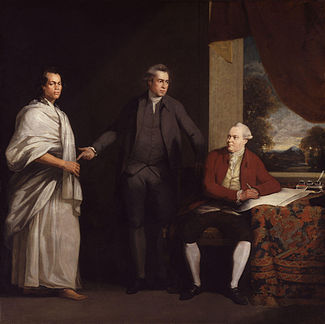- Omai
-
Mai (c.1751-1780), mistakenly known as Omai in Britain, was a young Ra'iatean man who became the second Pacific Islander to visit Europe, after Ahu-toru who was brought to Paris by Bougainville in 1768. In August 1773 he embarked from Huahine on the British ship HMS Adventure, commanded by Commander Tobias Furneaux, which had touched at Tahiti as part of James Cook's second voyage of discovery in the Pacific. Omai travelled to Europe on Adventure, arriving at London in October 1774 where he was introduced into society by the naturalist Sir Joseph Banks.[1]
His portrait was painted by Sir Joshua Reynolds among others, and his journey to England and subsequent return to Tahiti with Cook on his third voyage in 1776 became the subject of a theatrical production, written and directed by the dramatist John O'Keefe, entitled Omai – A Voyage ‘round the World that was performed during the 1785 Christmas season at London’s Theatre Royal in Covent Garden.
Omai served as an interpreter to Cook on both his second and third voyages. He settled in Huahine on his return to the Pacific. During the Bounty's visit to Tahiti in 1789, Captain Bligh was told Omai had died about two and a half years after Cook's departure in November 1777.[2]
References
- ^ Salmond, Anne (2003), The Trial of the Cannibal Dog, New Haven, CT: Yale University Press, p. 3, ISBN 9780300100921, http://yalepress.yale.edu/yupbooks/book.asp?isbn=9780300100921
- ^ "Temporary Export Bar For 'Outstanding' Reynolds' Portrait Of Omai" (Press release). United Kingdom Department for Culture, Media and Sport. 17 December 2002. http://www.culture.gov.uk/reference_library/media_releases/2884.aspx. Retrieved 6 December 2008.
Further reading
- Connaughton, Richard (2005), Omai: The Prince Who Never Was, London: Timewell Press, ISBN 1857252055, http://www.timewellpress.com/book-publishers/bookpage.php?isbn=1-85725-205-5
External links
- Omai, Captain Cook Birthplace Museum website

This article about an explorer is a stub. You can help Wikipedia by expanding it.

